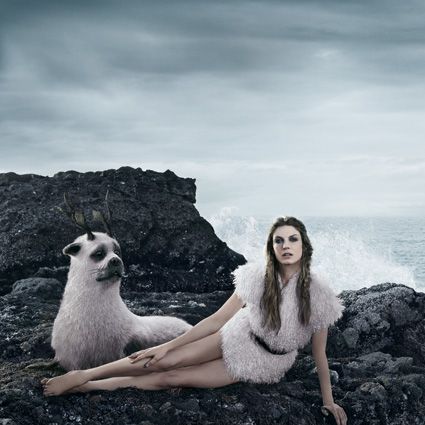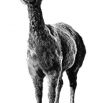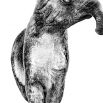It caught my eye because of its retro graphics and the cute panda on the cover. I thought it was vintage, and bought it for my son. In fact, The Way of the Panda by Henry Nicholls was written in 2010, one year ahead of the 50th anniversary of the World Wildlife Fund as it says on the sleeve, and is a fascinating account of the history of the panda, China and the conservation movement.
The giant panda is one of the most instantly recognizable animals in the world, not least, because back in 1961 it became the torch bearer of the WWF logo, designed by painter and ornithologist Peter Scott, one of the Fund’s founders.
Delving into my new book purchase I am surprised to read that the panda ‘bear’ (zoologically rather a raccoon), was discovered as recently as 1869. Just over 140 years ago! It was a French priest and keen naturalist by the name of Armand David ‘who became the first Westerner to first clap eyes on this extraordinary beast,’ I am told. Just as, or even more astounding, is the fact that there are no firm accounts of previous sightings or depictions of pandas throughout the whole history of China.
I remind myself that even our popular penguins haven’t been known for all that long. Their first breeding colony was discovered in 1902 by Skelton on Scott’s Antarctic Discovery Expedition, and the latest group of emperor penguins was first visited weeks ago, January 2013, detected through guano staines visible on satellite images.
- So it shouldn’t come as such a surprise then, that as recently as 2012 three new animal species were discovered, almost simultaneously, in areas as far apart as California’s Pasadena Valley, the Indian Ocean and Capetown.
But the truly amazing fact is, that the buffaloon, the bamboseal and the dolyphan all have one unusual feature in common. Albeit for different reasons each, they all relinquish their fur voluntarily, readily, generously, regularly, for man to gather and clad themselves with.
The news of the discovery made big waves in the zoological as well as in the fashion world, and decided to act. The result: the first ever natural non fur fashion collection of Wonder World Fur designed by Boudicca – with the very furs of the buffaloon, bamboseal and dolyphan: no harm to no-one and benefit to all. Wonder World Fur donates all financial benefits to WWF France, is created sustainably in Europe, saves animals and helps save more. Your bamboseal vest looks good, feels good and does good on many levels. Has your shopping ever been this rewarding? Try, and tell me.
WONDER WORLD FUR
And the animals discovered are....buffaloon, bamboseal, dolyphan.... >>>
The bufaloon is a camelid with an abundance of fur. It can be distinguished from the Llama by its lemur-like head, as well as by a little white patch in the shape of a heart that adorns its chest, as if it were a sign of peace to other species. The first bufaloons were discovered by zoologist Winnie Wendy Forsythe during her study of coyotes in California’s Pasadena Valley. Bufaloons sleep standing up to avoid damaging their fur. They eat thistles and thorns that regularly leads to ‘deflation’ at shoulder height, as well as a loss of fur. We say that the bufaloon ‘loons’ because of its emotional complaint that sounds rather similar to a child deprived of dessert. A hermaphrodite, the bufaloon mates with itself, replenishing our ecosystem with adorable bufalooneys. — The bufaloon is certified 100% imaginary.
Discovered recently on the border of the Atlantic and Indian oceans by fishermen of the Weston and Weston Company, the bamboseal is a sea lion with long, curly fur that helps to protect it from the climactic brutality of its environment. Extremely timid, the bamboseal spends the large majority of its time hiding in a nest of seaweed that also doubles as a larder and camouflages its nestlike silhouette. The bamboseal leaves its nest 8 times a year to find a mate and reproduce – each excursion occurring during the 8 lowest tides on the calendar. Its reproductive method differentiates it greatly from other phocids such as walruses and seals because it uses its splendid tusks to have babies. — The bamboseal is certified 100% imaginary.
Discovered in Autumn 2012 by Walter Watson Forman in the Capetown region of South Africa, the dolyphan lives a tranquil existence in the more remote parts of the forest. A mammal belonging to the Trunkacia family, the dolyphan is particularly appreciative of the beauty of trees and sunsets. Shy and emotional, it sheds its fur when scared. And nothing scares him more than wild potatoes, which Cape Town has in abundance.
It takes shelter in its burrow, so one must wait patiently for it to resurface if one is to hear its magnificent cry, with a melodious timbre not dissimilar the trumpet in Louis Armstrong’s ‘What a Wonderful World’. The dolyphan only eats petrea volubilis, small violet flowers that it sucks up using its trunk. Extremely reserved, the dolyphan only reproduces once a year, giving birth to up to 3000 babies at a time. — The dolyphan is certified 100% imaginary.
Wonder World Fur

 Wonder World Fur for WWF - Buffaloon coat - model Angela Lindvall, photo: Mark Seliger
">
Wonder World Fur for WWF - Buffaloon coat - model Angela Lindvall, photo: Mark Seliger
"> Wonder World Fur for WWF - Dolyphan bag - model Angela Lindvall, photo: Mark Seliger
">
Wonder World Fur for WWF - Dolyphan bag - model Angela Lindvall, photo: Mark Seliger
"> Buffaloon - A camelid with an abundance of fur. The bufaloon is certified 100% imaginary.
">
Buffaloon - A camelid with an abundance of fur. The bufaloon is certified 100% imaginary.
">
 Dolyphan - A mammal belonging to the Trunkacia family. The dolphin is certified 100% imaginary.
">
Dolyphan - A mammal belonging to the Trunkacia family. The dolphin is certified 100% imaginary.
"> Wonder World Fur for WWF - Bamboseal vest with midnight blue Eri silk belt and interior, WWF range of accessories - photo: Tomek Sierek
">
Wonder World Fur for WWF - Bamboseal vest with midnight blue Eri silk belt and interior, WWF range of accessories - photo: Tomek Sierek
"> Wonder World Fur for WWF - Bamboseal mittens - photo: Tomek Sierek
">
Wonder World Fur for WWF - Bamboseal mittens - photo: Tomek Sierek
">
 Wonder World Fur for WWF - Dolyphan I pad bag - photo: Tomek Sierek
">
Wonder World Fur for WWF - Dolyphan I pad bag - photo: Tomek Sierek
"> Wonder World Fur for WWF - Dolyphan bag - photo: Tomek Sierek
">
Wonder World Fur for WWF - Dolyphan bag - photo: Tomek Sierek
"> Wonder World Fur for WWF - Bamboseal headband - photo: Tomek Sierek">
Wonder World Fur for WWF - Bamboseal headband - photo: Tomek Sierek">

 Wonder World Fur for WWF - Buffaloon coat - model Angela Lindvall, photo: Mark Seliger
">
Wonder World Fur for WWF - Buffaloon coat - model Angela Lindvall, photo: Mark Seliger
"> Wonder World Fur for WWF - Dolyphan bag - model Angela Lindvall, photo: Mark Seliger
">
Wonder World Fur for WWF - Dolyphan bag - model Angela Lindvall, photo: Mark Seliger
"> Buffaloon - A camelid with an abundance of fur. The bufaloon is certified 100% imaginary.
">
Buffaloon - A camelid with an abundance of fur. The bufaloon is certified 100% imaginary.
">
 Dolyphan - A mammal belonging to the Trunkacia family. The dolphin is certified 100% imaginary.
">
Dolyphan - A mammal belonging to the Trunkacia family. The dolphin is certified 100% imaginary.
"> Wonder World Fur for WWF - Bamboseal vest with midnight blue Eri silk belt and interior, WWF range of accessories - photo: Tomek Sierek
">
Wonder World Fur for WWF - Bamboseal vest with midnight blue Eri silk belt and interior, WWF range of accessories - photo: Tomek Sierek
"> Wonder World Fur for WWF - Bamboseal mittens - photo: Tomek Sierek
">
Wonder World Fur for WWF - Bamboseal mittens - photo: Tomek Sierek
">
 Wonder World Fur for WWF - Dolyphan I pad bag - photo: Tomek Sierek
">
Wonder World Fur for WWF - Dolyphan I pad bag - photo: Tomek Sierek
"> Wonder World Fur for WWF - Dolyphan bag - photo: Tomek Sierek
">
Wonder World Fur for WWF - Dolyphan bag - photo: Tomek Sierek
"> Wonder World Fur for WWF - Bamboseal headband - photo: Tomek Sierek">
Wonder World Fur for WWF - Bamboseal headband - photo: Tomek Sierek">




















